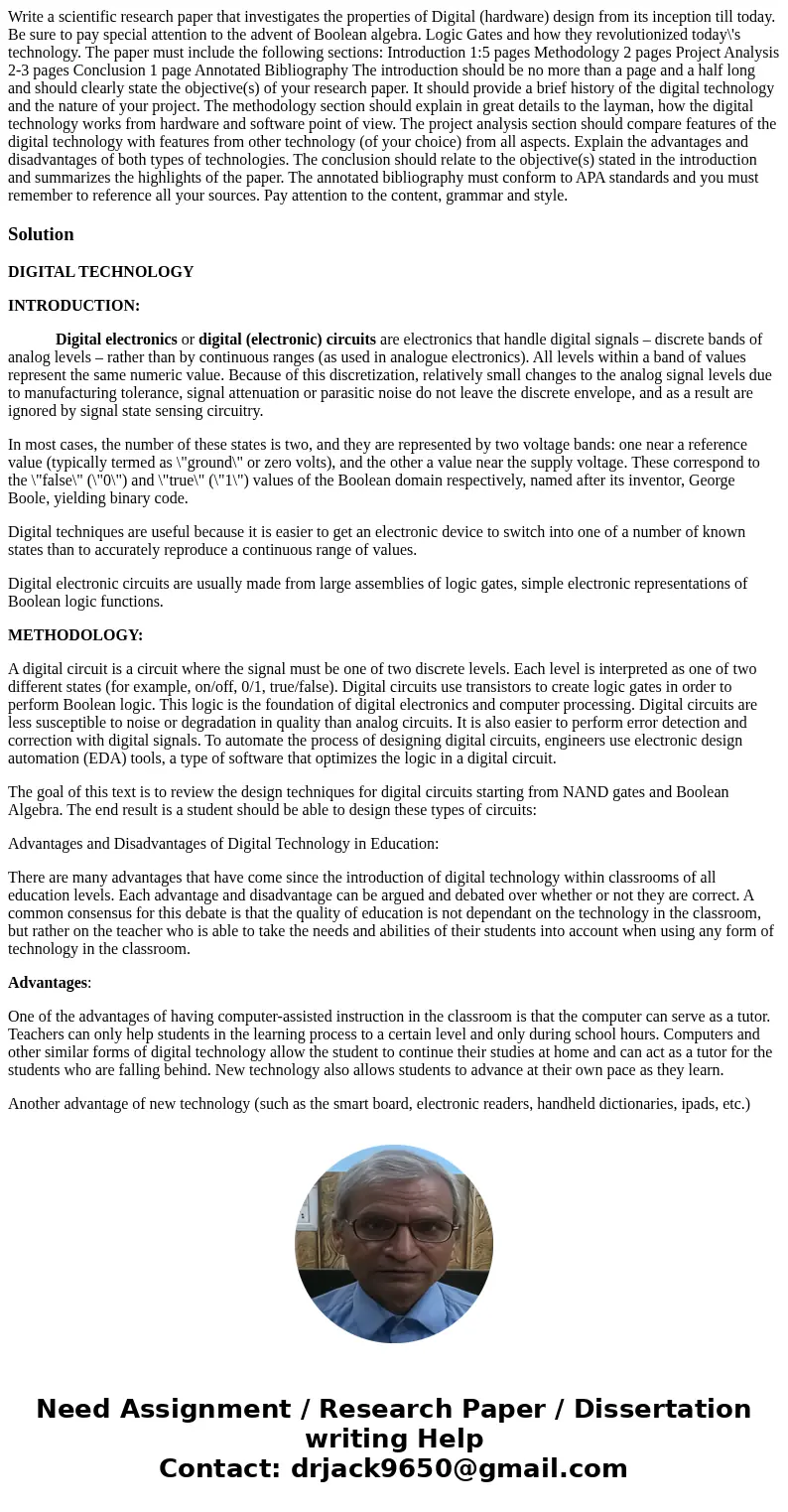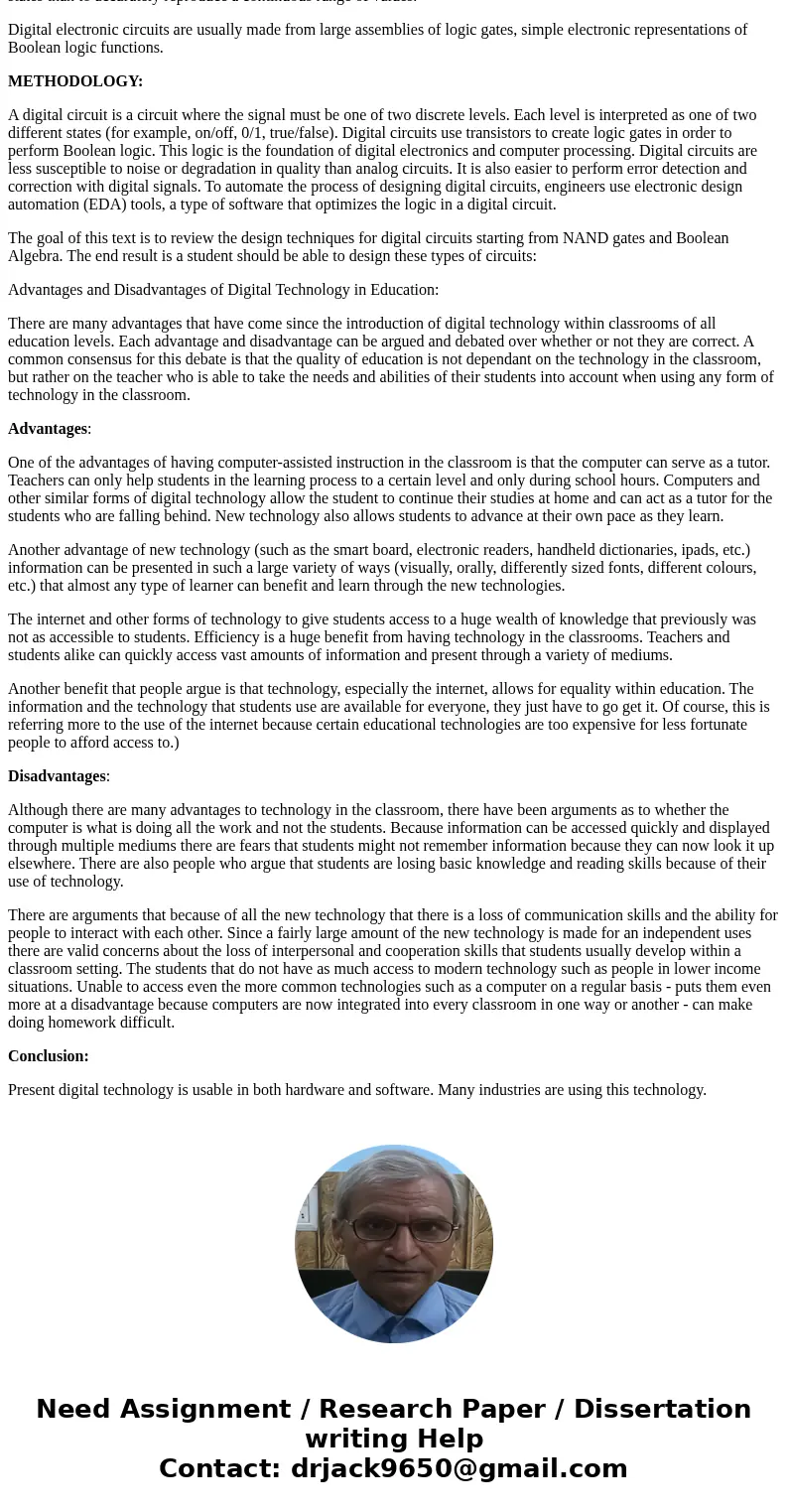Write a scientific research paper that investigates the prop
Solution
DIGITAL TECHNOLOGY
INTRODUCTION:
Digital electronics or digital (electronic) circuits are electronics that handle digital signals – discrete bands of analog levels – rather than by continuous ranges (as used in analogue electronics). All levels within a band of values represent the same numeric value. Because of this discretization, relatively small changes to the analog signal levels due to manufacturing tolerance, signal attenuation or parasitic noise do not leave the discrete envelope, and as a result are ignored by signal state sensing circuitry.
In most cases, the number of these states is two, and they are represented by two voltage bands: one near a reference value (typically termed as \"ground\" or zero volts), and the other a value near the supply voltage. These correspond to the \"false\" (\"0\") and \"true\" (\"1\") values of the Boolean domain respectively, named after its inventor, George Boole, yielding binary code.
Digital techniques are useful because it is easier to get an electronic device to switch into one of a number of known states than to accurately reproduce a continuous range of values.
Digital electronic circuits are usually made from large assemblies of logic gates, simple electronic representations of Boolean logic functions.
METHODOLOGY:
A digital circuit is a circuit where the signal must be one of two discrete levels. Each level is interpreted as one of two different states (for example, on/off, 0/1, true/false). Digital circuits use transistors to create logic gates in order to perform Boolean logic. This logic is the foundation of digital electronics and computer processing. Digital circuits are less susceptible to noise or degradation in quality than analog circuits. It is also easier to perform error detection and correction with digital signals. To automate the process of designing digital circuits, engineers use electronic design automation (EDA) tools, a type of software that optimizes the logic in a digital circuit.
The goal of this text is to review the design techniques for digital circuits starting from NAND gates and Boolean Algebra. The end result is a student should be able to design these types of circuits:
Advantages and Disadvantages of Digital Technology in Education:
There are many advantages that have come since the introduction of digital technology within classrooms of all education levels. Each advantage and disadvantage can be argued and debated over whether or not they are correct. A common consensus for this debate is that the quality of education is not dependant on the technology in the classroom, but rather on the teacher who is able to take the needs and abilities of their students into account when using any form of technology in the classroom.
Advantages:
One of the advantages of having computer-assisted instruction in the classroom is that the computer can serve as a tutor. Teachers can only help students in the learning process to a certain level and only during school hours. Computers and other similar forms of digital technology allow the student to continue their studies at home and can act as a tutor for the students who are falling behind. New technology also allows students to advance at their own pace as they learn.
Another advantage of new technology (such as the smart board, electronic readers, handheld dictionaries, ipads, etc.) information can be presented in such a large variety of ways (visually, orally, differently sized fonts, different colours, etc.) that almost any type of learner can benefit and learn through the new technologies.
The internet and other forms of technology to give students access to a huge wealth of knowledge that previously was not as accessible to students. Efficiency is a huge benefit from having technology in the classrooms. Teachers and students alike can quickly access vast amounts of information and present through a variety of mediums.
Another benefit that people argue is that technology, especially the internet, allows for equality within education. The information and the technology that students use are available for everyone, they just have to go get it. Of course, this is referring more to the use of the internet because certain educational technologies are too expensive for less fortunate people to afford access to.)
Disadvantages:
Although there are many advantages to technology in the classroom, there have been arguments as to whether the computer is what is doing all the work and not the students. Because information can be accessed quickly and displayed through multiple mediums there are fears that students might not remember information because they can now look it up elsewhere. There are also people who argue that students are losing basic knowledge and reading skills because of their use of technology.
There are arguments that because of all the new technology that there is a loss of communication skills and the ability for people to interact with each other. Since a fairly large amount of the new technology is made for an independent uses there are valid concerns about the loss of interpersonal and cooperation skills that students usually develop within a classroom setting. The students that do not have as much access to modern technology such as people in lower income situations. Unable to access even the more common technologies such as a computer on a regular basis - puts them even more at a disadvantage because computers are now integrated into every classroom in one way or another - can make doing homework difficult.
Conclusion:
Present digital technology is usable in both hardware and software. Many industries are using this technology.


 Homework Sourse
Homework Sourse